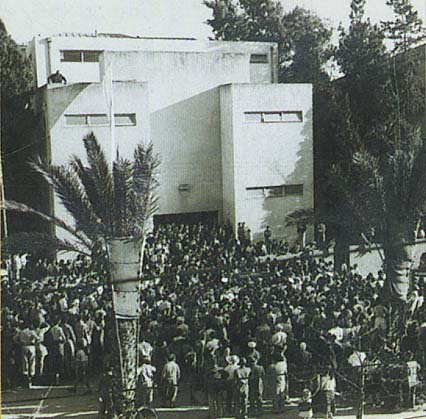Carl Rubin (architect) on:
[Wikipedia]
[Google]
[Amazon]
Carl Rubin (24 June 1899 – 7 February 1955) was an Israeli architect known for his work in the international style. He designed many of the iconic buildings in this style in 
 One of Rubin's important designs was his remodelling of the building that became Israel's
One of Rubin's important designs was his remodelling of the building that became Israel's
''Beit Hadar under construction, 1936''
in Yona Fischer, ed. ''Tel-Aviv: 75 Years of Art. Tel Aviv:'' Massada, 1984
Tel Aviv
Tel Aviv-Yafo ( he, תֵּל־אָבִיב-יָפוֹ, translit=Tēl-ʾĀvīv-Yāfō ; ar, تَلّ أَبِيب – يَافَا, translit=Tall ʾAbīb-Yāfā, links=no), often referred to as just Tel Aviv, is the most populous city in the G ...
.

Biography
Carl Rubin was born in 1899 inSniatyn
Sniatyn ( uk, Сня́тин, translit=Sniatyn; pl, Śniatyn; ro, Sneatîn, older ; yi, שניאַטין) is a town located in Kolomyia Raion of Ivano-Frankivsk Oblast, in western Ukraine along the Prut river. It is located at around . Sniaty ...
in Galicia. He studied architecture in Vienna
en, Viennese
, iso_code = AT-9
, registration_plate = W
, postal_code_type = Postal code
, postal_code =
, timezone = CET
, utc_offset = +1
, timezone_DST ...
. In 1920, Rubin immigrated
Immigration is the international movement of people to a destination country of which they are not natives or where they do not possess citizenship in order to settle as permanent residents or naturalized citizens. Commuters, tourists, and ...
to Eretz Israel
The Land of Israel () is the traditional Jewish name for an area of the Southern Levant. Related biblical, religious and historical English terms include the Land of Canaan, the Promised Land, the Holy Land, and Palestine (see also Isra ...
, settling in Tel Aviv. In 1931, Rubin returned to Berlin to work for Erich Mendelsohn
Erich Mendelsohn (21 March 1887 – 15 September 1953) was a German architect, known for his expressionist architecture in the 1920s, as well as for developing a dynamic Functionalism (architecture), functionalism in his projects for department ...
, an Allenstein
Olsztyn ( , ; german: Allenstein ; Old Prussian: ''Alnāsteini''
* Latin: ''Allenstenium'', ''Holstin'') is a city on the Łyna River in northern Poland. It is the capital of the Warmian-Masurian Voivodeship, and is a city with county rights. ...
-born Jewish architect whose architectural philosophy influenced Rubin's later designs.
In 1932, Rubin moved back to Tel Aviv in Mandate Palestine
Mandatory Palestine ( ar, فلسطين الانتدابية '; he, פָּלֶשְׂתִּינָה (א״י) ', where "E.Y." indicates ''’Eretz Yiśrā’ēl'', the Land of Israel) was a geopolitical entity established between 1920 and 1948 i ...
and opened his own architectural office, contributing to the development of Tel Aviv and UNESCO
The United Nations Educational, Scientific and Cultural Organization is a specialized agency of the United Nations (UN) aimed at promoting world peace and security through international cooperation in education, arts, sciences and culture. It ...
's later recognition of the "White City" as a World Heritage Site
A World Heritage Site is a landmark or area with legal protection by an international convention administered by the United Nations Educational, Scientific and Cultural Organization (UNESCO). World Heritage Sites are designated by UNESCO for h ...
.
Projects
Dizengoff House/Independence Hall
 One of Rubin's important designs was his remodelling of the building that became Israel's
One of Rubin's important designs was his remodelling of the building that became Israel's Independence Hall
Independence Hall is a historic civic building in Philadelphia, where both the United States Declaration of Independence and the United States Constitution were debated and adopted by America's Founding Fathers of the United States, Founding Fa ...
(at Rothschild Boulevard 16). In 1932, Rubin resigned the home of Mayor of Tel Aviv Me'ir Dizengoff, who donated it to the city as the first home of the Tel Aviv Museum of Art
Tel Aviv Museum of Art ( he, מוזיאון תל אביב לאמנות ''Muzeon Tel Aviv Leomanut'') is an art museum in Tel Aviv, Israel. The museum is dedicated to the preservation and display of modern and contemporary art from Israel and aroun ...
.
Dr. Sadovsky House
Rubin designed numerous residential complexes in Tel Aviv. One of these buildings, the home of Dr. Sadovsky (85,Rothschild Boulevard
Rothschild Boulevard (, ''Sderot Rotshild'') is one of the principal streets in the center of Tel Aviv, Israel, beginning in Neve Tzedek at its southwestern edge and running north to Habima Theatre. It is one of the most expensive streets in the c ...
), designed in 1933, sold for 7 million dollars in 2007.
Citrus House/Beit Hadar
In 1935–1936, Rubin designed the Beit Hadar office building aka Citrus House, the first in Tel Aviv with asteel frame
Steel frame is a building technique with a "skeleton frame" of vertical steel columns and horizontal I-beams, constructed in a rectangular grid to support the floors, roof and walls of a building which are all attached to the frame. The developm ...
structure.Photo: Itzhak Kalter''Beit Hadar under construction, 1936''
in Yona Fischer, ed. ''Tel-Aviv: 75 Years of Art. Tel Aviv:'' Massada, 1984
References
{{DEFAULTSORT:Rubin, Carl Architects in Mandatory Palestine Israeli architects 1899 births 1955 deaths